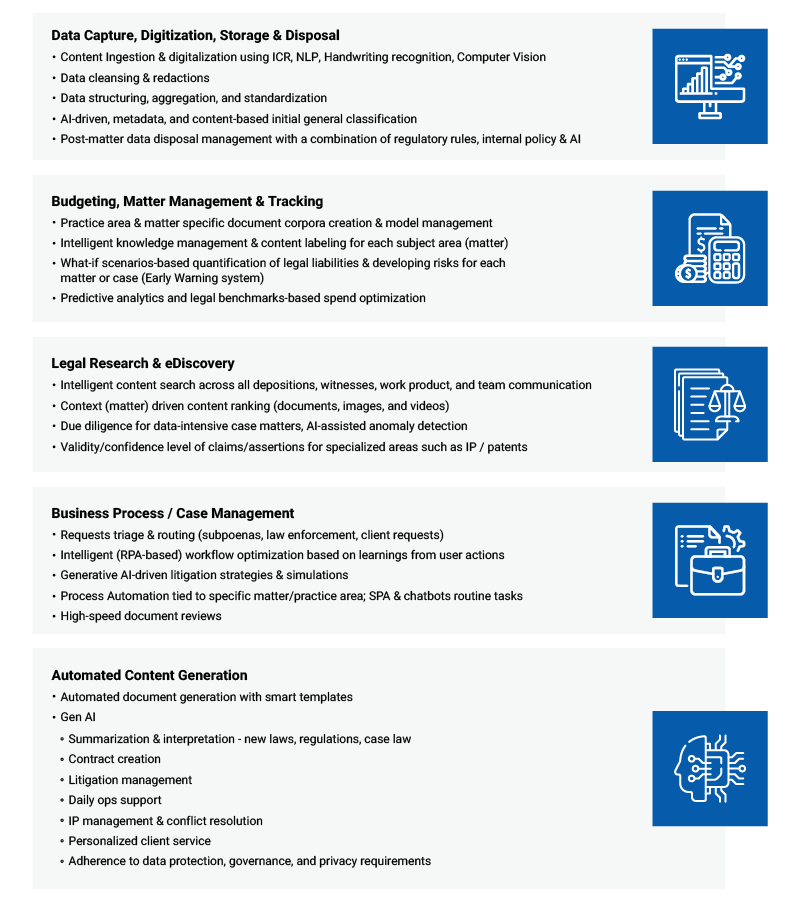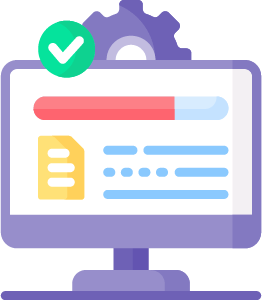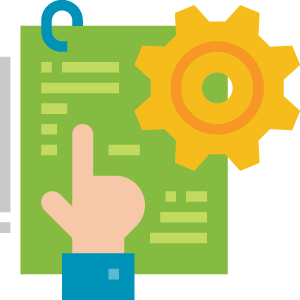This website uses cookies. By continuing to browse the site, you are agreeing to our use of cookies
Leveraging AI for a Transformative Impact in the Legal Industry
The legal industry extensively deals with various data types, particularly managing substantial volumes of unstructured data that necessitate precise human reasoning. This field offers significant potential for multiple applications of artificial intelligence. Commoditized services, which are relatively simpler and more standardized, are already benefiting from AI assistance, leading to improved outcomes, enhanced efficiency, and overall progress. Nevertheless, the greatest value lies in more complex services, such as civil and criminal litigation, which require intricate strategies.
Therefore, an effective assimilation of statutes, regulations, and historical case content serves as the foundation for harnessing AI’s transformative power in research, case management, and content generation. However, this potential must be reinforced with robust data governance, diligent knowledge management, and thorough human oversight to ensure accountability.
Understanding Distinct Legal Service Categories
The legal industry demands a lot of nuances for analyzing and correlating information from diverse sources. This is pertinent for lawyers navigating case law, paralegals who hold informal but profoundly critical roles, and even court judges. Beyond pursuing justice in individual cases, court decisions and obiter dicta establish enduring trends with implications for affirmative actions shaping a more equitable society.
The services proffered by legal firms encompass a spectrum that spans two categories:
- Commoditized services: These pertain to tasks like handling deeds, wills, mortgages, and standardized business contracts. They cater to day-to-day business transactions and address legal needs as they arise in the course of an individual’s life. While these tasks can be quantified to some degree in terms of effort and, subsequently, billable hours, a significant portion comprises administrative duties necessitating the qualification, authenticity, and scrutiny of legal experts.
- Non-commoditized services: Efforts in this category resist easy quantification, especially within the realm of intricate civil and criminal cases or specialized business services. These complex matters require the implicit expertise ingrained in the minds of seasoned lawyers and paralegals. Legal research, serving as the bedrock for such services, can be extensive and time-consuming. The actual value, however, is less a matter of the hours expended but guided more by the approach to potential outcomes, the cogent persuasion grounded in case law, and the ‘confidence levels’ attached to positive results.
Navigating Challenges in Revenue Growth and Risk Mitigation
Like any other entities, legal firms seek to enhance the predictability of their revenue and cash flows. Among their services, commoditized offerings, which revolve around specific ‘matters’ and lean toward routine processes, are already capitalizing on automation and cognitive technologies. These technologies entail minimal error risks, effectively reducing human errors. Notable instances include automated data sifting, extraction, and redaction in documents, alongside populating data into standardized templates. Utilizing Robotic Process Automation (RPA) for straightforward tasks (with eventual Human-in-the-loop confirmations and maker-checker-approver policies) is another illustration of this trend.
However, the more formidable challenge lies in non-commoditized or bespoke services. A meticulous assessment of all pertinent information depends heavily on analyzing legal texts, statutes, industry-specific regulations, and even deeply technical subjects. In these scenarios, the emphasis shifts from the largely standardized processes and templates characteristic of commoditized services (inclined toward rules-based processing). Instead, the focus sharpens on the precision of inferences founded on correlations within extensive and sometimes disparate information groups.
Much like the operation of neural networks, each approach can be conceptualized as a sequence of steps, with the progression to the next step governed by a ‘weight.’ For instance, in a class-action lawsuit, a data expert might offer analytics supporting the historical impact of technology, followed by an industry expert’s assessment of its environmental consequences, and finally, the representing lawyer’s assertions grounded in both these perspectives and the experiences of those affected by inadequately tested technology. The court decisions in such cases become synonymous with considerable financial implications (in terms of compensations and penalties), and as such services for these can’t be ‘transactionally priced’ like commoditized services.
While legal cases inherently exhibit unique aspects, and a definitive bespoke solution may not exist for any given scenario, AI technology can serve as a robust foundation for devising strategies with varying confidence levels at every step of each strategy and, eventually, of the probability of a favorable outcome.
The below exhibit brings out the application of AI in various legal areas, starting with data capture.
Application of AI Technologies in the Legal Domain


Data Integrity, Accuracy, and Management: A robust data governance strategy, in tandem with AI assistance, is pivotal in ensuring that pertinent parties have appropriate access to data. This holds paramount significance in the legal sphere, particularly practices like Forensics and eDiscovery, which necessitate services from external legal counsels and designated data custodians. This approach also facilitates compliance with pertinent regulations. With AI’s aid, modern data platforms facilitate the alignment with evolving data structures. This proves particularly beneficial as new data entities and attributes make their way into the scene. Understanding such dynamic data is crucial for investigative cases, such as when subpoenas are involved. For unstructured data, creating reliable and comprehensive document using text content sourced from case law and precedents serves to mitigate risk and strengthen assertions. The classification of documents and other content forms (videos, images) based on distinct attributes might adopt a gradual approach, commencing with unsupervised learning for a ‘base’ classification. This could then integrate a mechanism enabling supervised learning tailored to diverse subject ‘areas’ for secondary-level classification. In this paradigm, the same document, at the tertiary level, could receive varying rankings based on the specific ‘context,’ such as a lawyer’s work product. Moreover, these models can be retrained as per evolving requirements, thereby ensuring relevance and accuracy.

Matter Management: At the ‘matter’ level, a deep understanding of specific practices, combined with insightful Customer Relationship Management (CRM) analytics, ensures a steady revenue stream by effectively pitching clients with suitable services. In this context, AI plays a pivotal role in implementing systems that foster proactive assimilation of changing industry and regulatory developments, thus helping anticipate the demand for legal services from professionals and paralegal experts. This approach aids in identifying favorable upcoming areas, facilitating more precise opportunity funneling. Additionally, it assists in recognizing developing situations that might escalate into legal liability or unmanageable expenses. Early Warning Systems may be designed on such principles, thereby enabling a proactive response.

Legal Research, Knowledge Management & eDiscovery: A robust Knowledge Management (KM) methodology hinges on a well-structured organization of ‘topics’ pertinent to various matter areas within a comprehensive repository, serving as an initial step. Knowledge authoring and tagging for supervised learning should be entrusted solely to experts within well-organized focus groups within the legal firm or designated external specialists. This collective body must consistently understand the methodologies and taxonomies in use. Deviation from this approach might hinder desired research outcomes or render the system unusable at the extreme. A strong KM system also forms the right basis for Fraud Management and eDiscovery. For instance, models trained on data from a comprehensive KM system that has comprehensive and accurate data on past cases with well-segregated legal practice domains can prove invaluable for eDiscovery exercises or investigative audits. Known fraud patterns can be unearthed far more quickly than with standalone human reasoning and correlations.

Business Process & Legal Case Management: Legal firms often exhibit diverse working styles and organizational cultures. Even if processes are comparable within a specific legal practice area, customizable case management templates, synergized with AI models, can yield great benefits. Legal experts can tap into accurate case law content and analytical insights from past cases, enhancing their strategies for desired outcomes. However, here, AI’s role should be restricted to bolstering the comprehensiveness of processes, speeding up operations, introducing checkpoints, and augmenting data coverage for managed cases. It should refrain from ‘leading’ to biased inferences. In this context, ‘Explainable’ AI is paramount, ensuring any AI-derived inferences merely complement the independent conclusions drawn by human experts.

Automated Document Generation and Content Creation: Beyond creating documents and reports through standard or decision-driven templates, Generative AI has made remarkable strides in the past year. Large Language Models (LLMs), including models like GPT-4, are increasingly finding utility in novel applications. Some of these include:
- Summarizing intricate statutes and offering interpretations.
- Drafting complex business contract language, suggesting amendments, and rectifying typographical and factual errors.
- Ensuring compliance with various legally required formats
- Ensuring that sensitive data and content are shared with only the appropriate parties in varied capacities – a critical requirement within any legal scenario.
- Generating legal strategies for arguments, coupled with sequencing, descriptions, and supporting litigation arguments with emphasis and references from case law.
- Providing daily activity support in legal workflows through suggestions for content and assistance for decisions with adequate explanations
- Offering support for Intellectual Property (IP) management, particularly in IP conflict scenarios.
- Enhancing personalization of user and client experience through chatbots that provide responses tailored to specific business objectives or case considerations.
However, Generative AI requires ensuring that legal enterprise datasets used for information extraction by LLMs are accurate and well-segregated so that they don’t contain erroneous information and that LLMs are retrained appropriately as enterprise data multiplies. Also, it requires mechanisms to ensure that confidential information and PII data (which may be input by users through prompts) not only stay in the ambits of the legal organization but also be segregated between departments in the legal organization through Chinese walls.
Final Thoughts
There is significant potential for AI-driven business transformation within the legal sector, with several legal firms utilizing AI-based solutions in creative ways. It simply cannot be dismissed as a high-risk, low-reward endeavor; however, human oversight remains indispensable. The strategies employed need to be prudent to avoid compromising on either the stability of processes or the accuracy of outcomes. Implementing proper governance and control mechanisms becomes crucial to mitigate new risks and financial liabilities proactively. By doing so, AI can genuinely emerge as a valuable asset for legal firms.
About the Author

Arun Narayanan
With over 25 years of experience in Consulting, Pre-Sales, and Thought Leadership, Arun Narayanan leads the High Tech & Professional Services (HTPS) practice at Hexaware Technologies and is a key member of the Gen AI Consulting & Practice (North America) team. As an accomplished HTPS and Gen AI leader, Arun excels in driving meaningful business outcomes through technology. His expertise in customer management, combined with a strong focus on Strategy and Domain-specific solutions, enables him to deliver comprehensive services that effectively meet customer needs.
Read more
About the Author

Alok Mishra
Read more
Related Blogs

What Is Generative AI Consulting?
- Generative AI
- Digital & Software Solutions

AI in Global Capability Centers: Navigating People Challenges in Adoption
- Global Capability Centers
- Generative AI

Generative AI in Claims Processing: The AI Station for the Claims Ecosystem
- Insurance
- Generative AI

AI-Powered Dynamic Pricing: The New Retail Reality that Enhances Precision and Profitability
- Retail & CPG
- Generative AI

Agentic AI in Insurance: Transforming the Industry with Enterprise AI
- Insurance
- Generative AI

How Agentic AI is Transforming Pharma Sales: Hexaware’s Agentic AI Solutions
- Life Sciences & Healthcare
- Generative AI

Generative AI in Insurance: Transforming Challenges into Opportunities
- Insurance
- Generative AI

Ready to Pursue Opportunity?
Every outcome starts with a conversation










